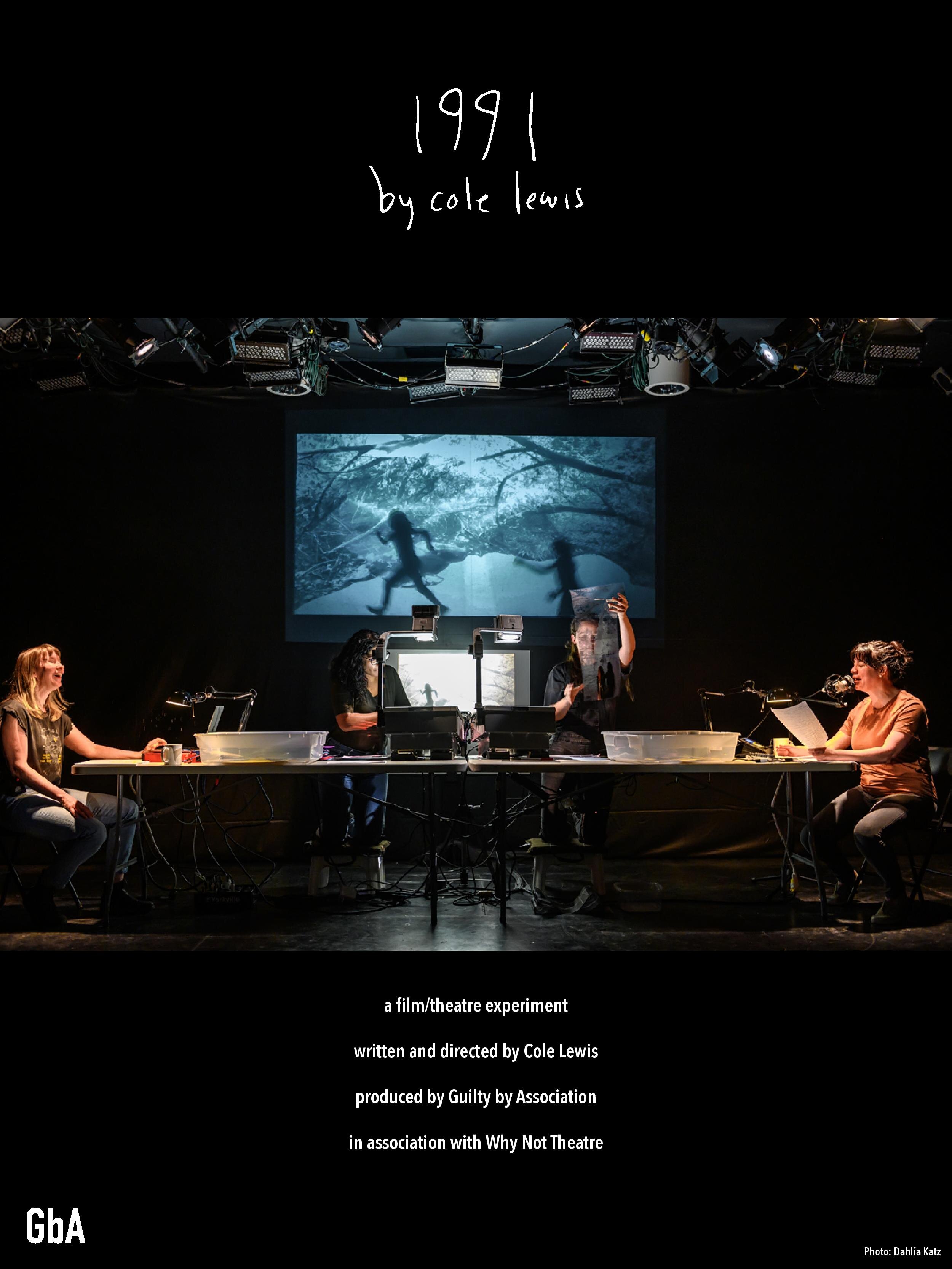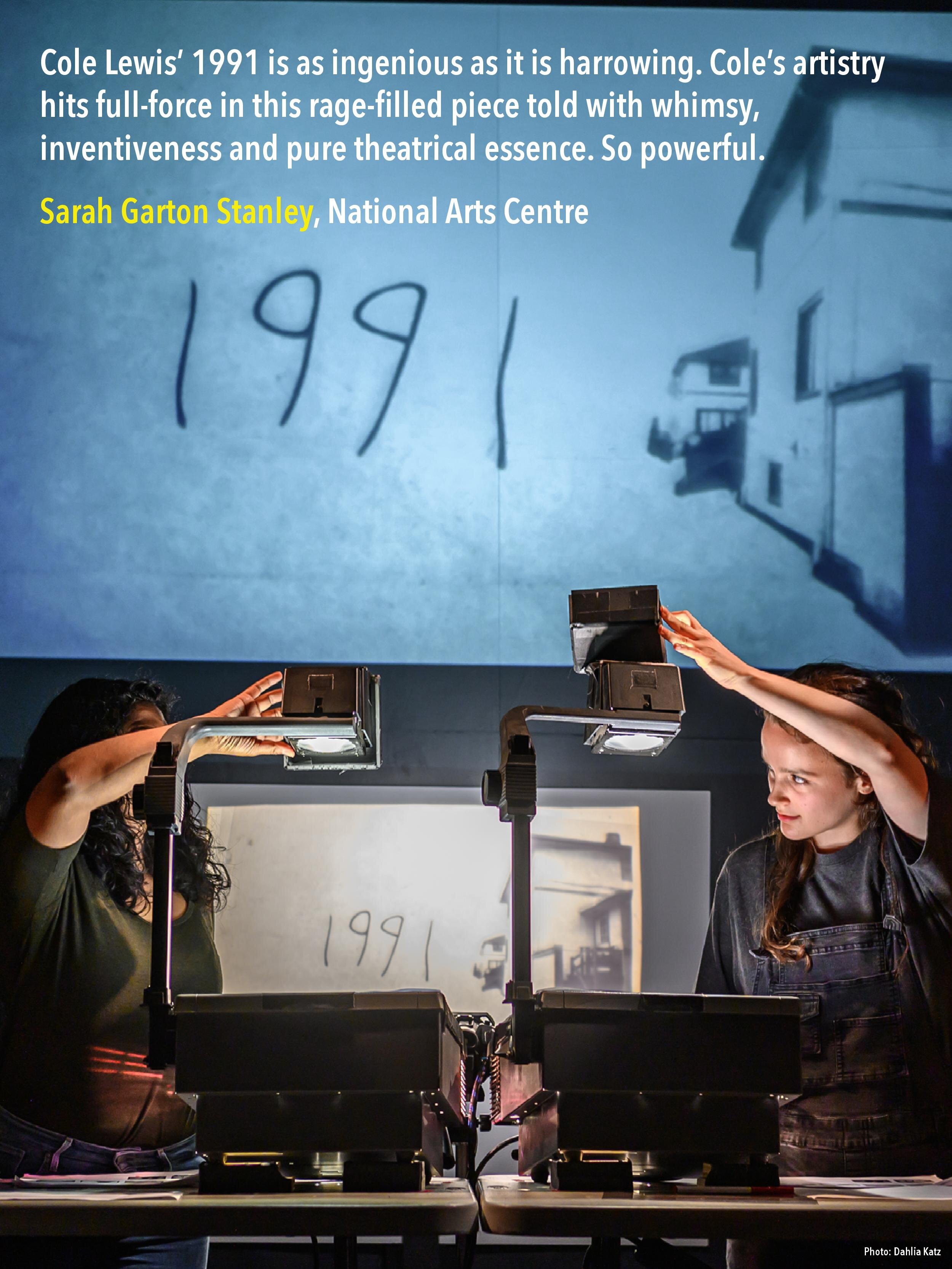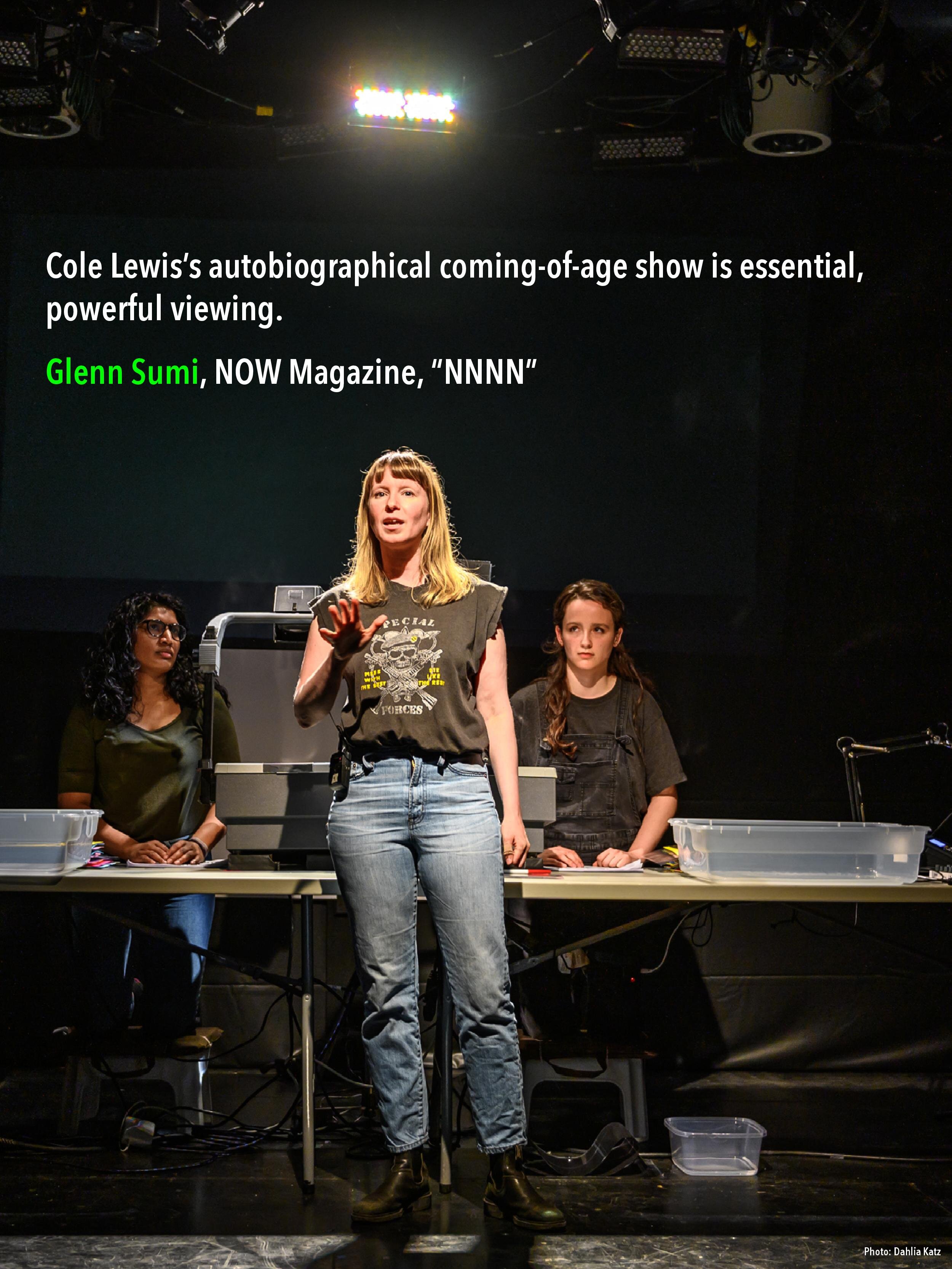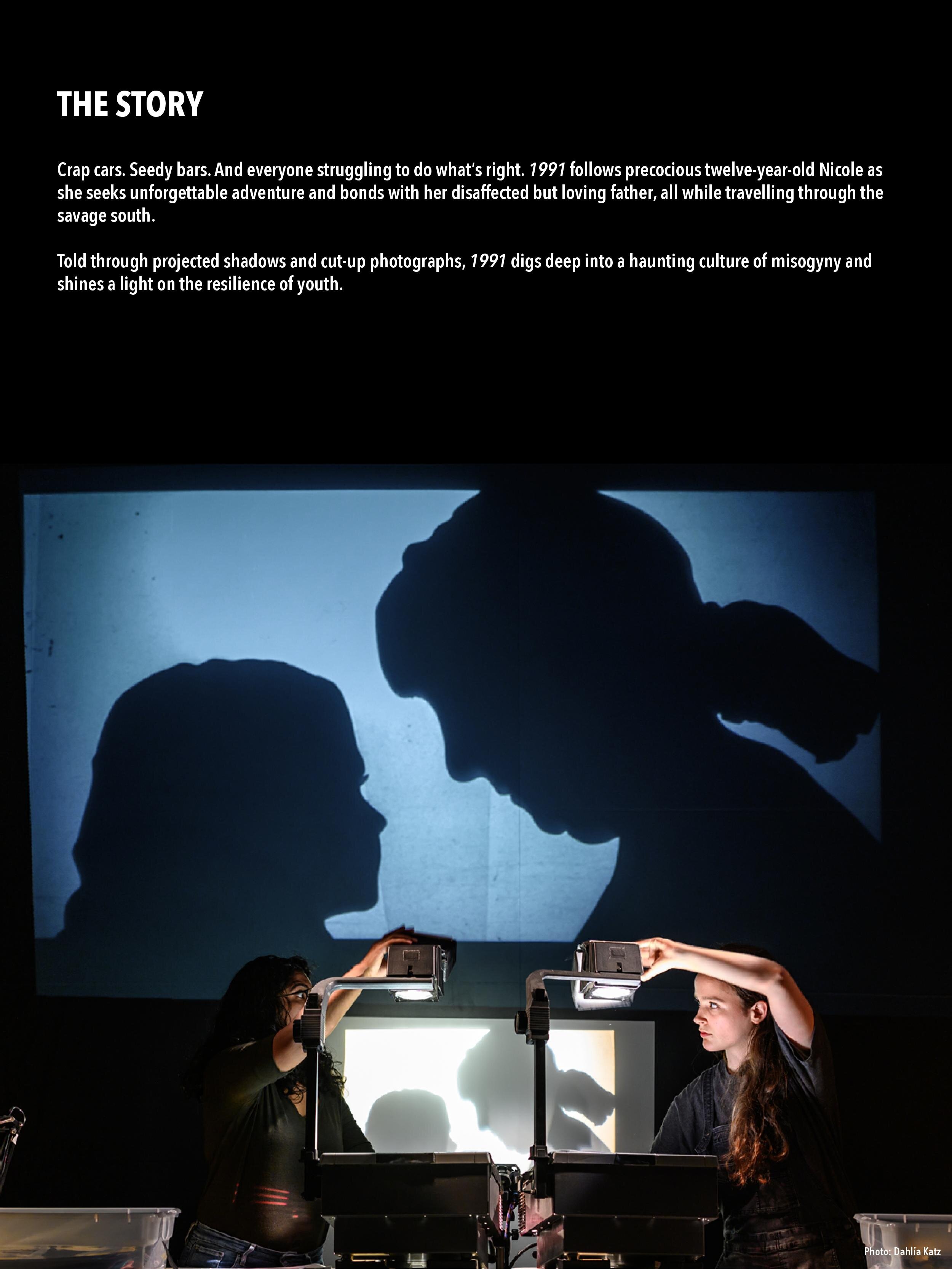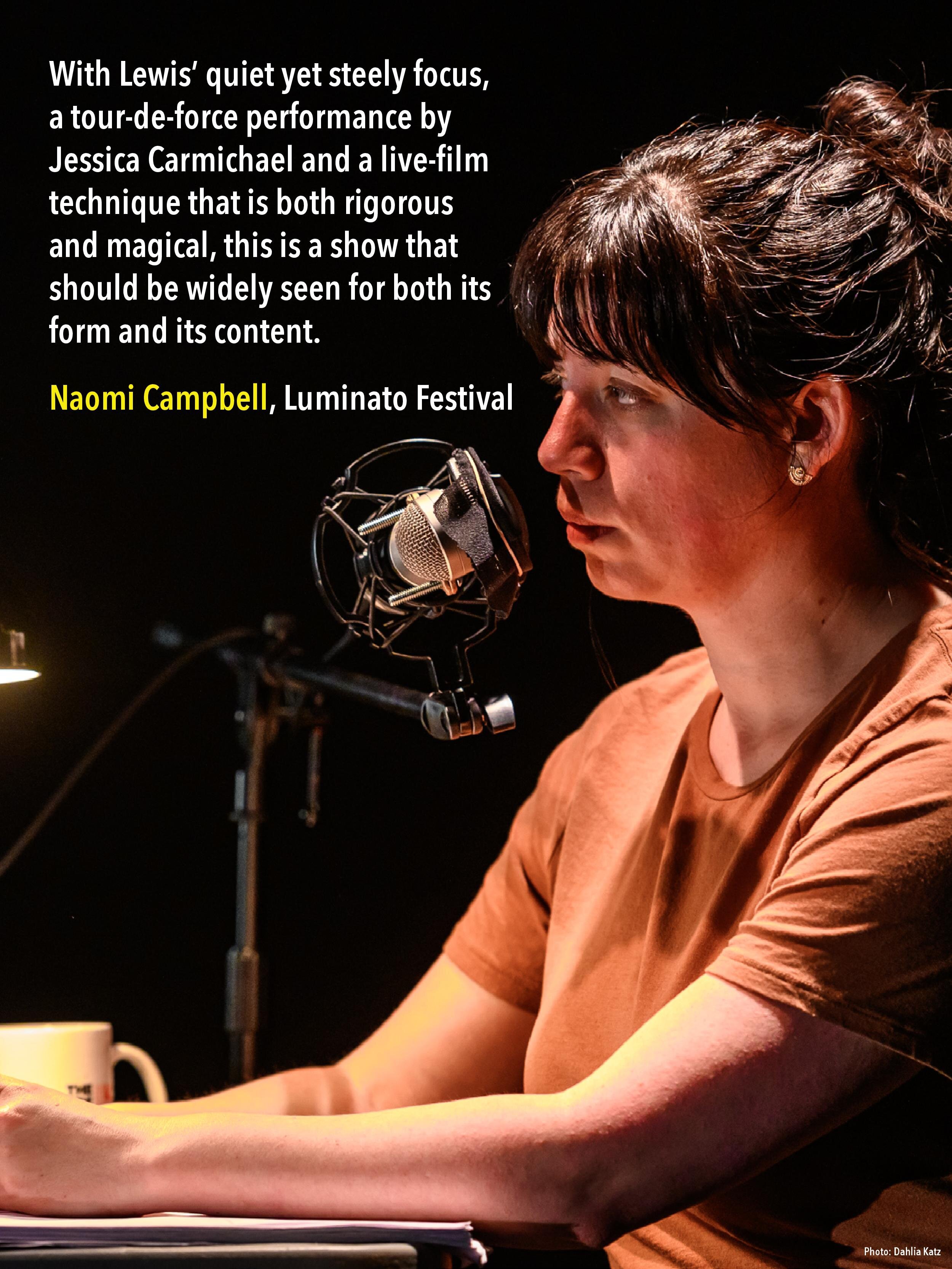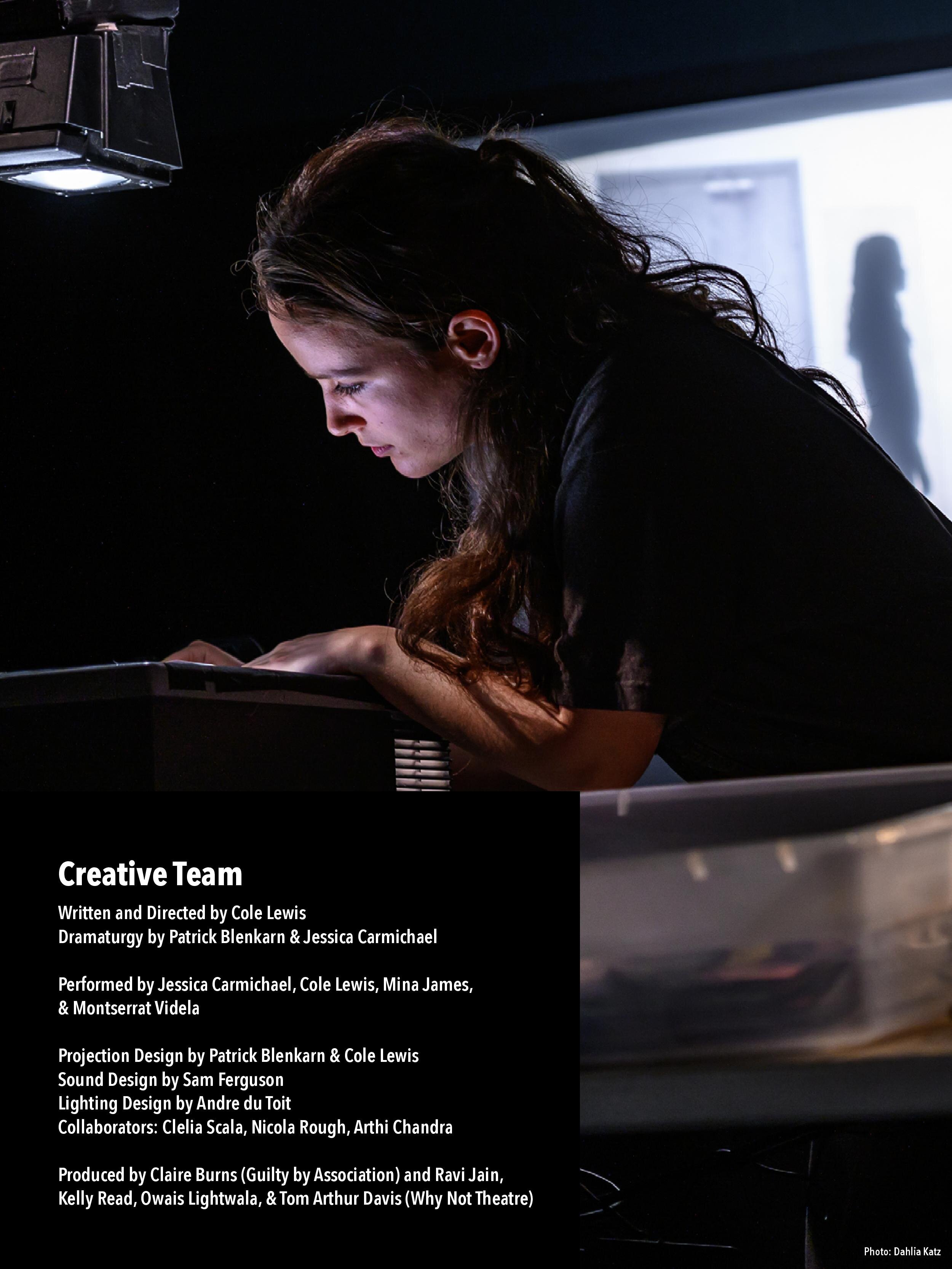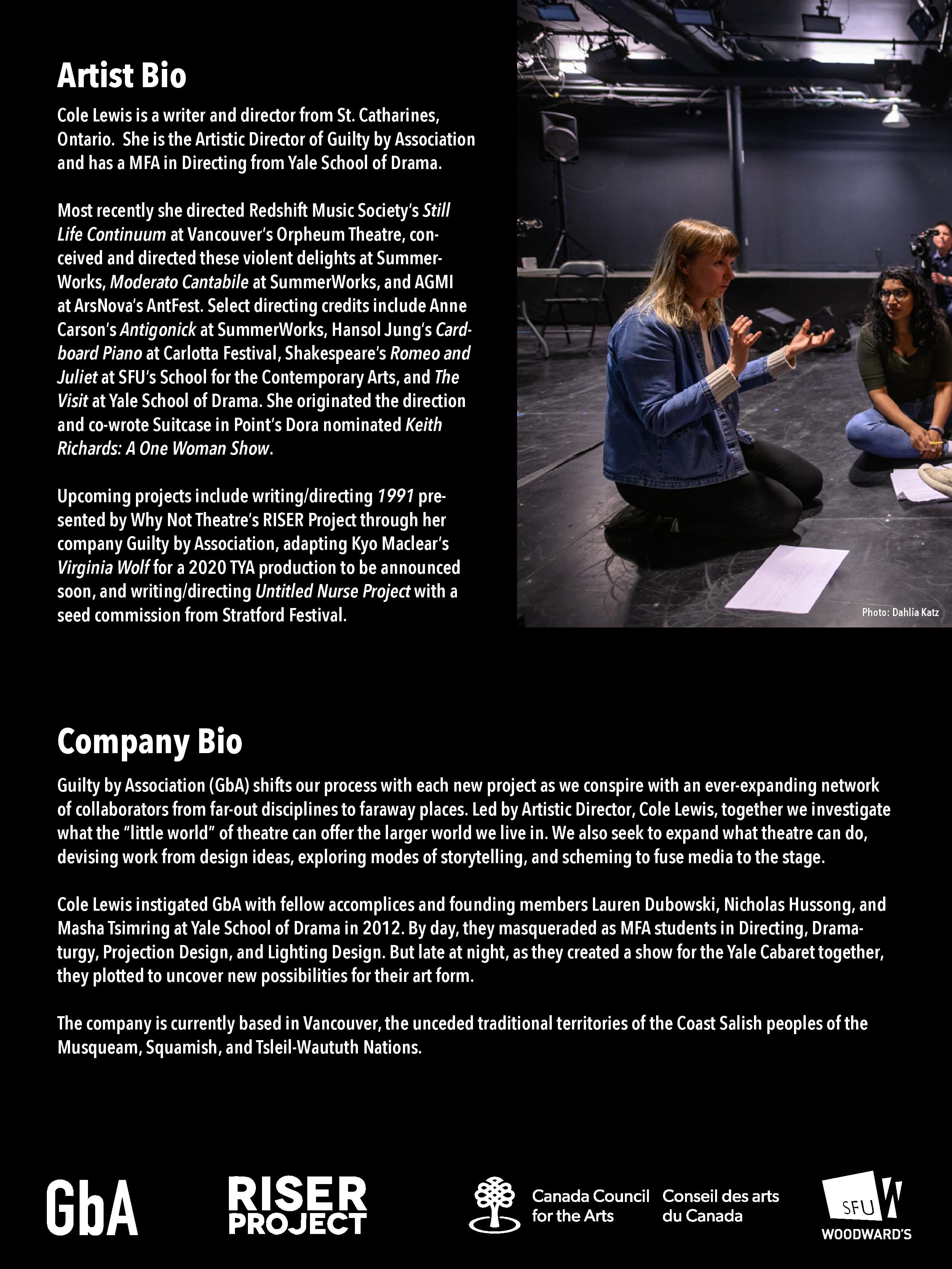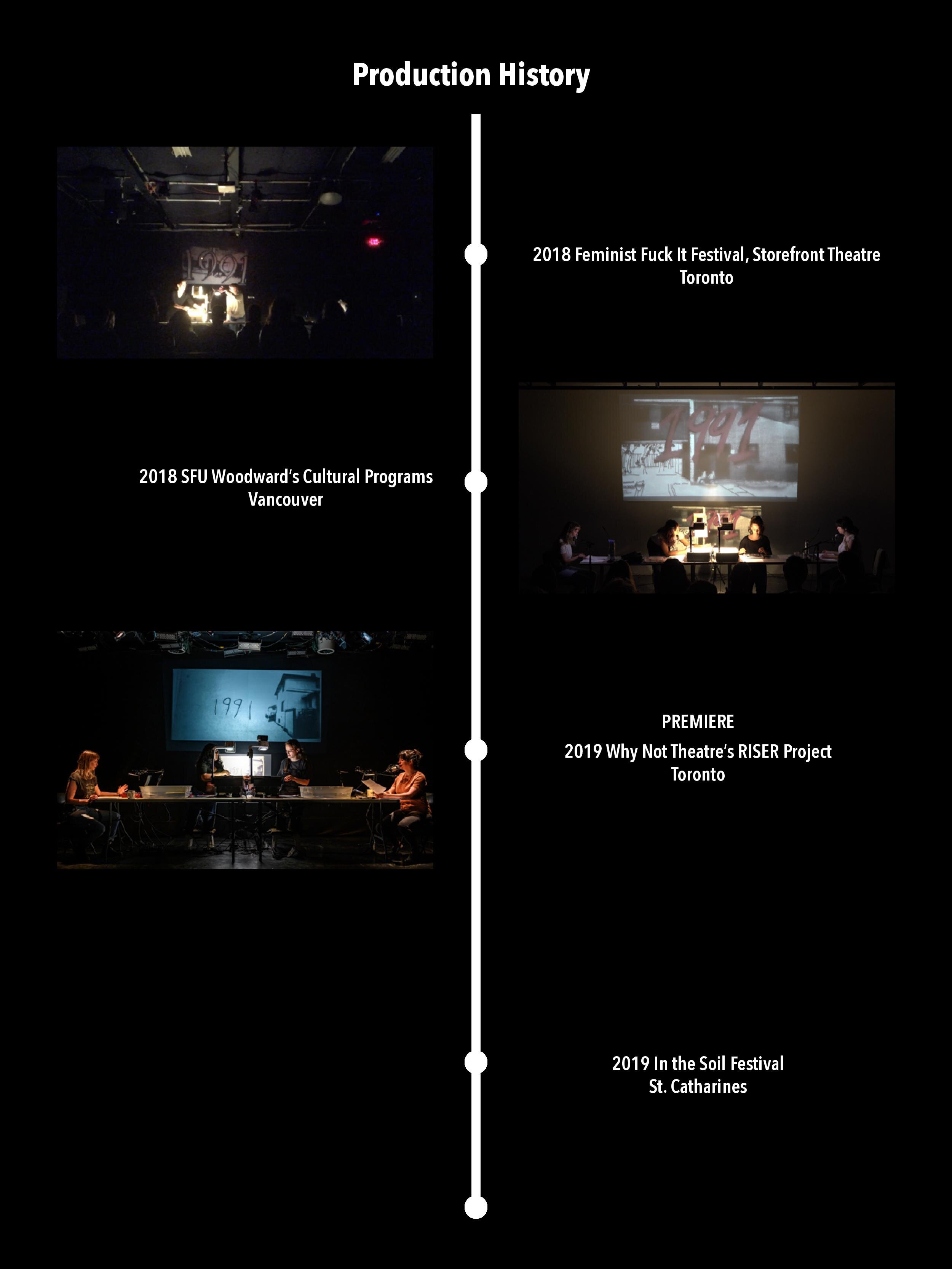1991
Touring Information
Cole Lewis’ 1991 is as ingenious as it is harrowing. Cole’s artistry hits full-force in this rage-filled piece told with whimsy, inventiveness and pure theatrical essence. So powerful.
— Sarah Garton Stanley, Associate Artistic Director, English Theatre, National Arts Centre
With Lewis’ quiet yet steely focus, a tour-de-force performance by Jessica Carmichael and a live-film technique that is both rigorous and magical, this is a show that should be widely seen for both its form and its content.
— Naomi Campbell, Artistic Director of Luminato Festival
TOURING BOOKLET
SHOW DESCRIPTION
Crap cars. Seedy bars. And everyone struggling to do what’s right. 1991 follows precocious twelve-year-old Nicole as she seeks unforgettable adventure and bonds with her disaffected but loving father, all while travelling through the savage south.
Told through projected shadows and cut-up photographs, 1991 digs deep into a haunting culture of misogyny and shines a light on the resilience of youth.
BILLING + CREDITING
Produced by Guilty by Association, presented by Why Not Theatre as part of RISER Project 2019
Written & Directed by Cole Lewis
Dramaturgy by Patrick Blenkarn and Jessica Carmichael
Performed by Jessica Carmichael, Cole Lewis, Mina James, and Montserrat Videla
Projection Design by Patrick Blenkarn and Cole Lewis
Sound Design by Sam Ferguson
Lighting Design by André du Toit
Produced by Claire Burns (Guilty by Association) and Ravi Jain, Kelly Read, Owais Lightwala, & Tom Arthur Davis (Why Not Theatre)
PRODUCTION IMAGES
Photos by Dahlia Katz
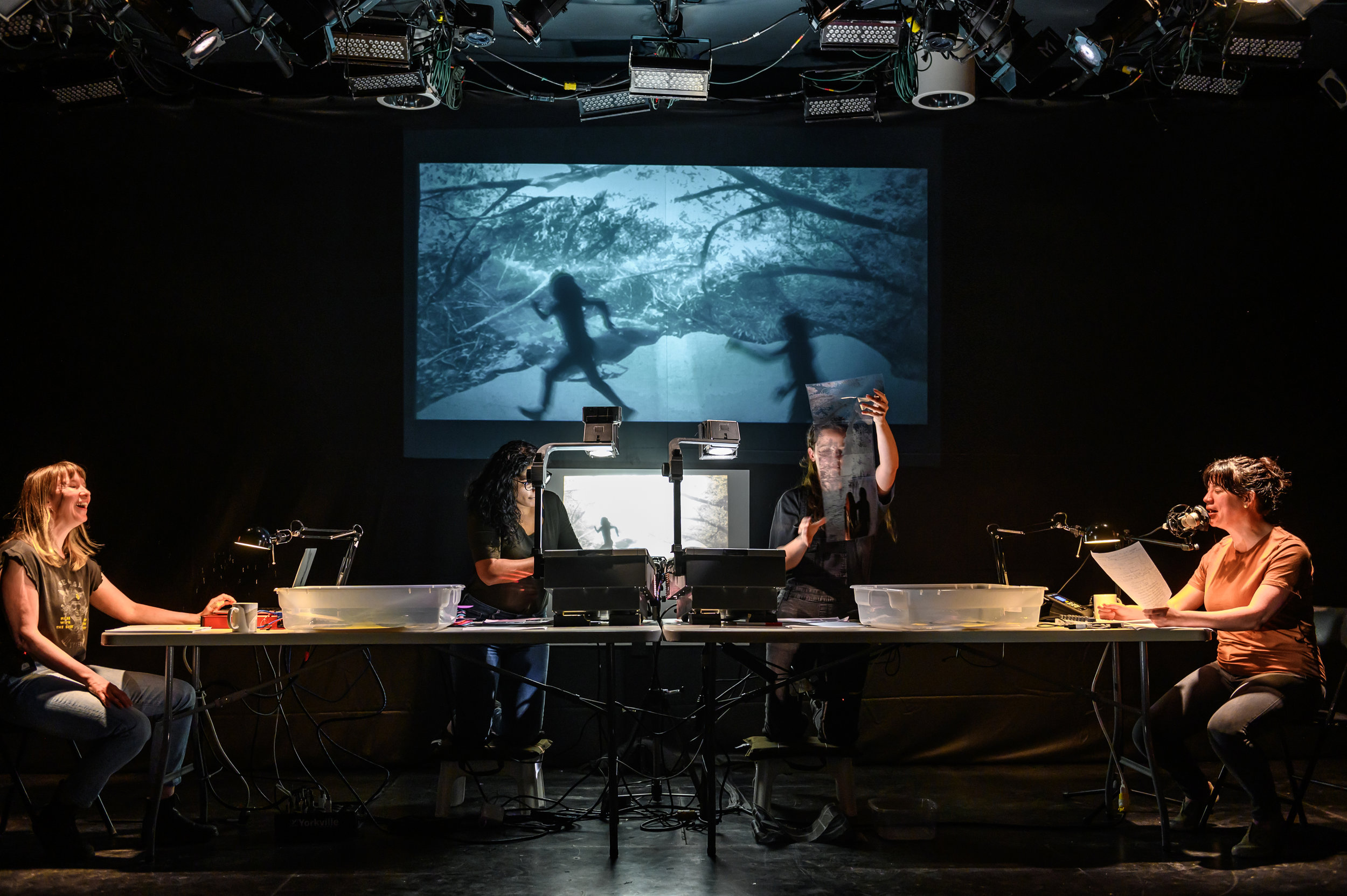

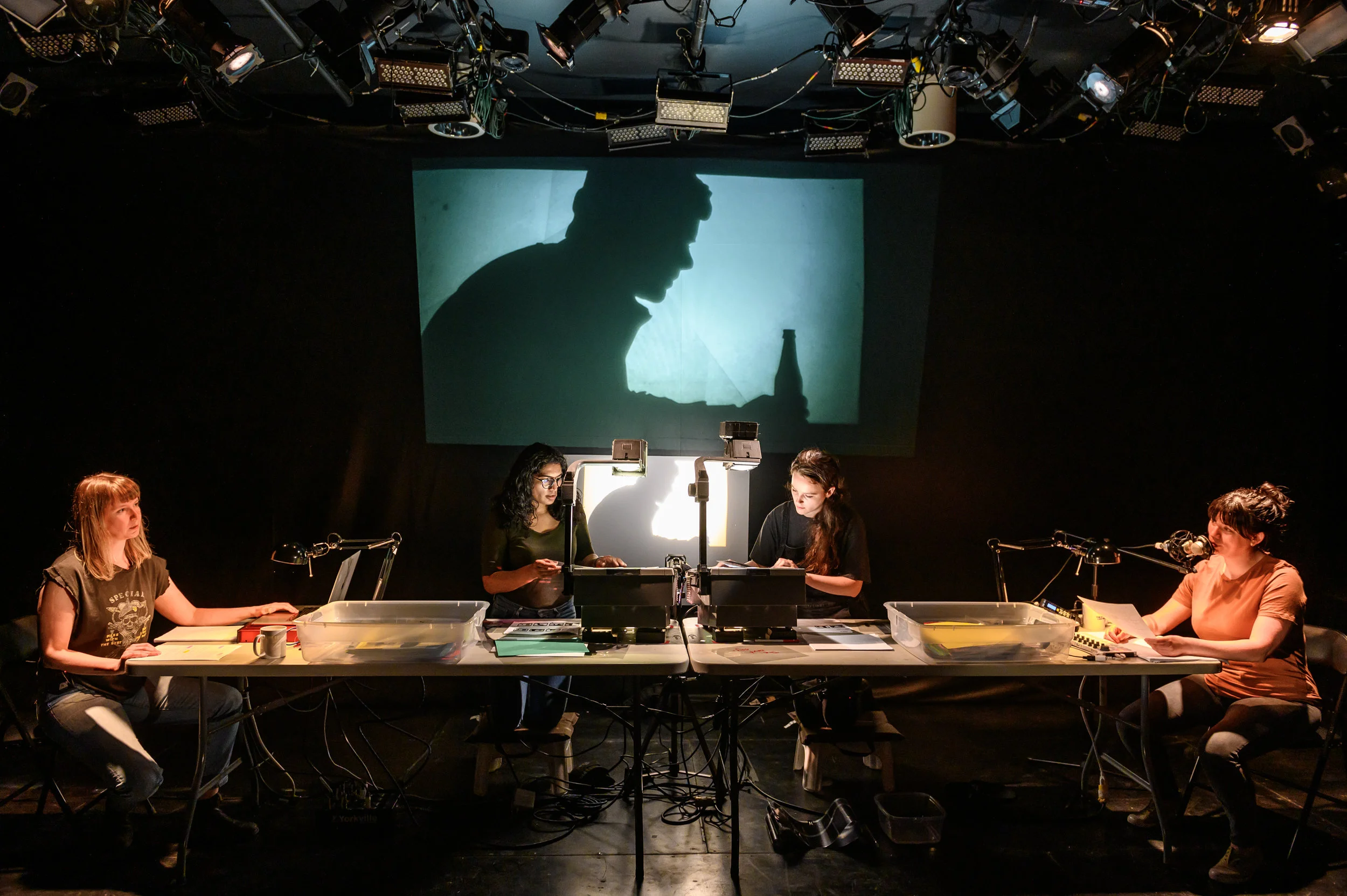
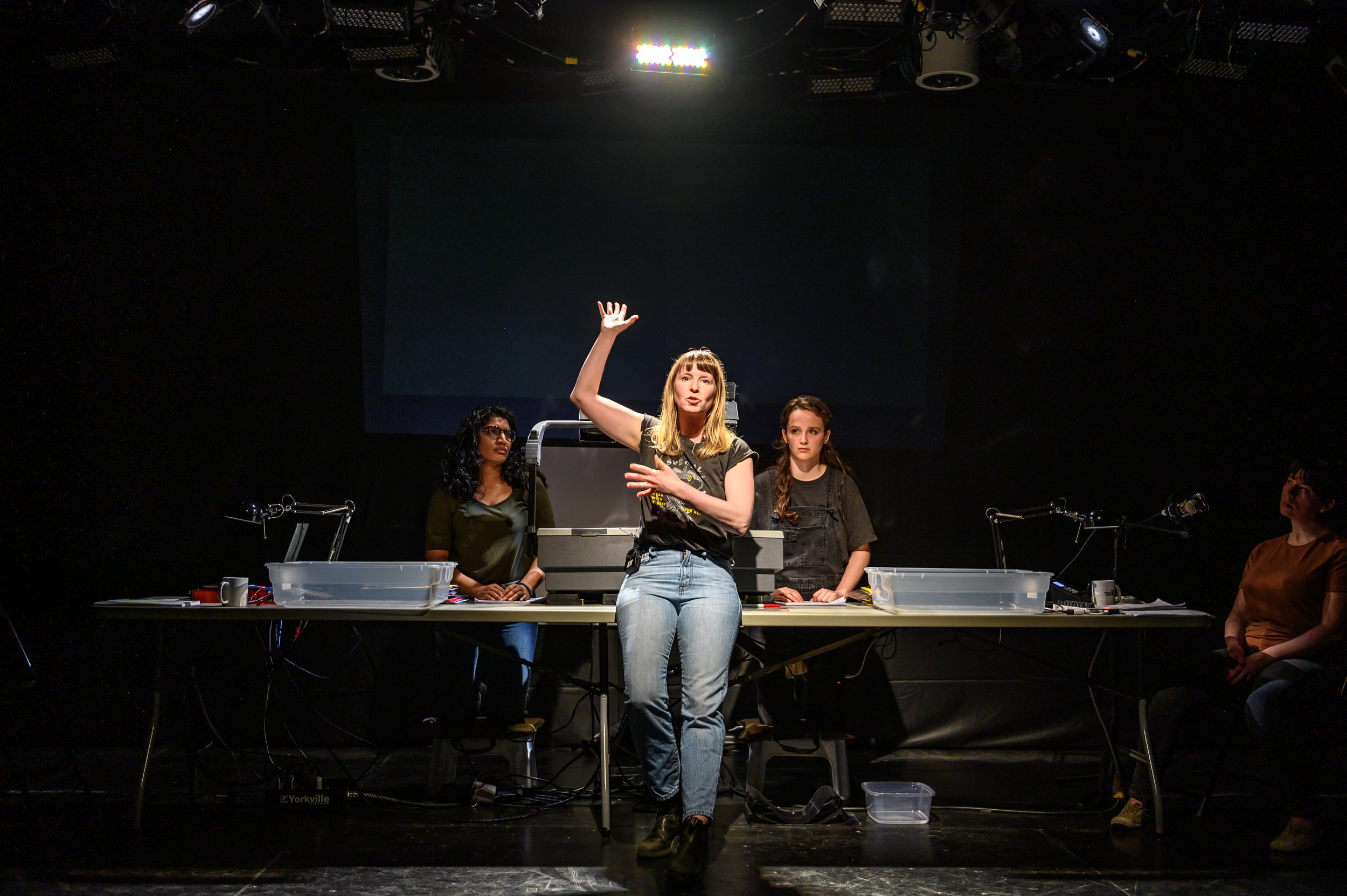
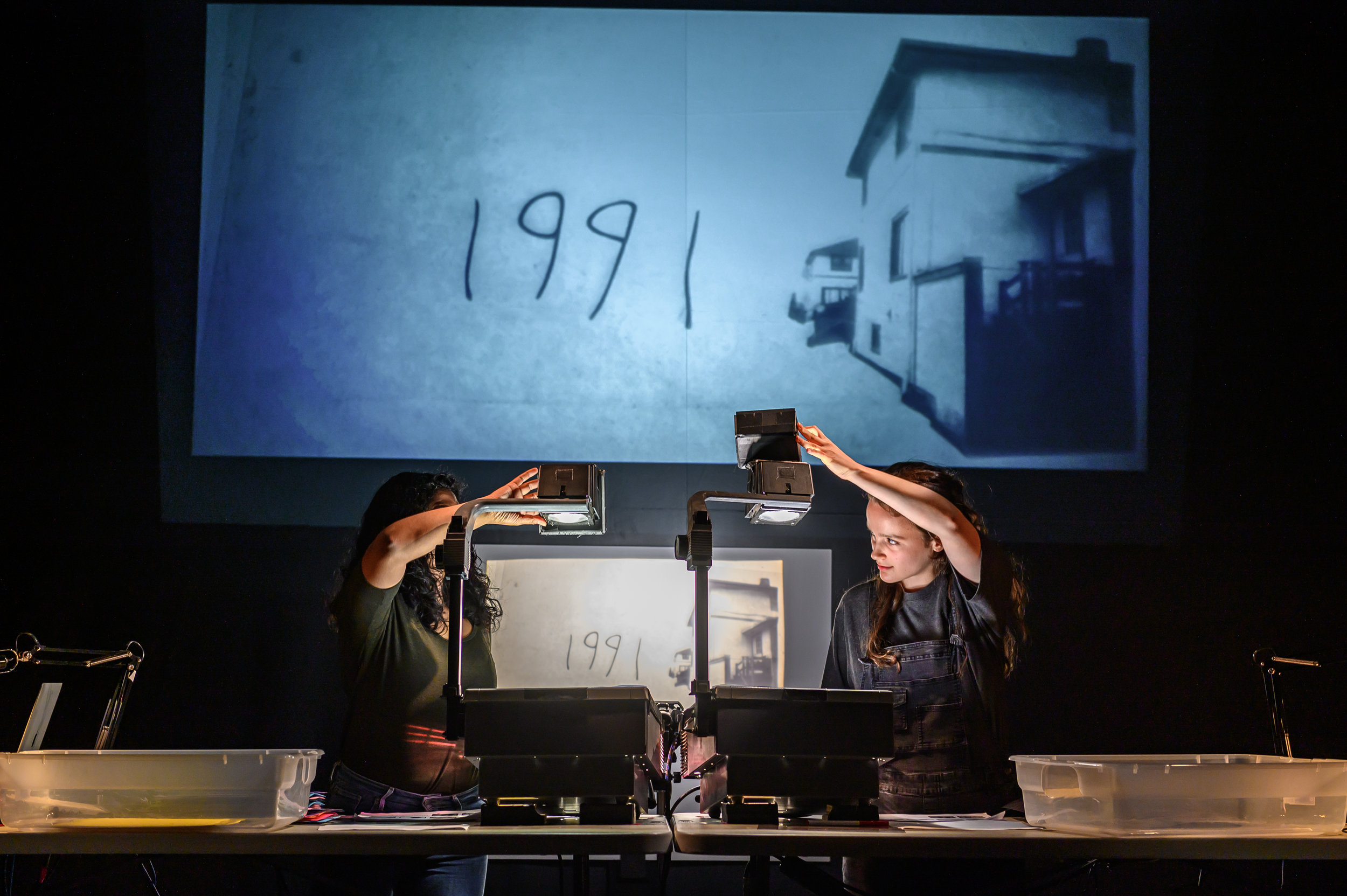
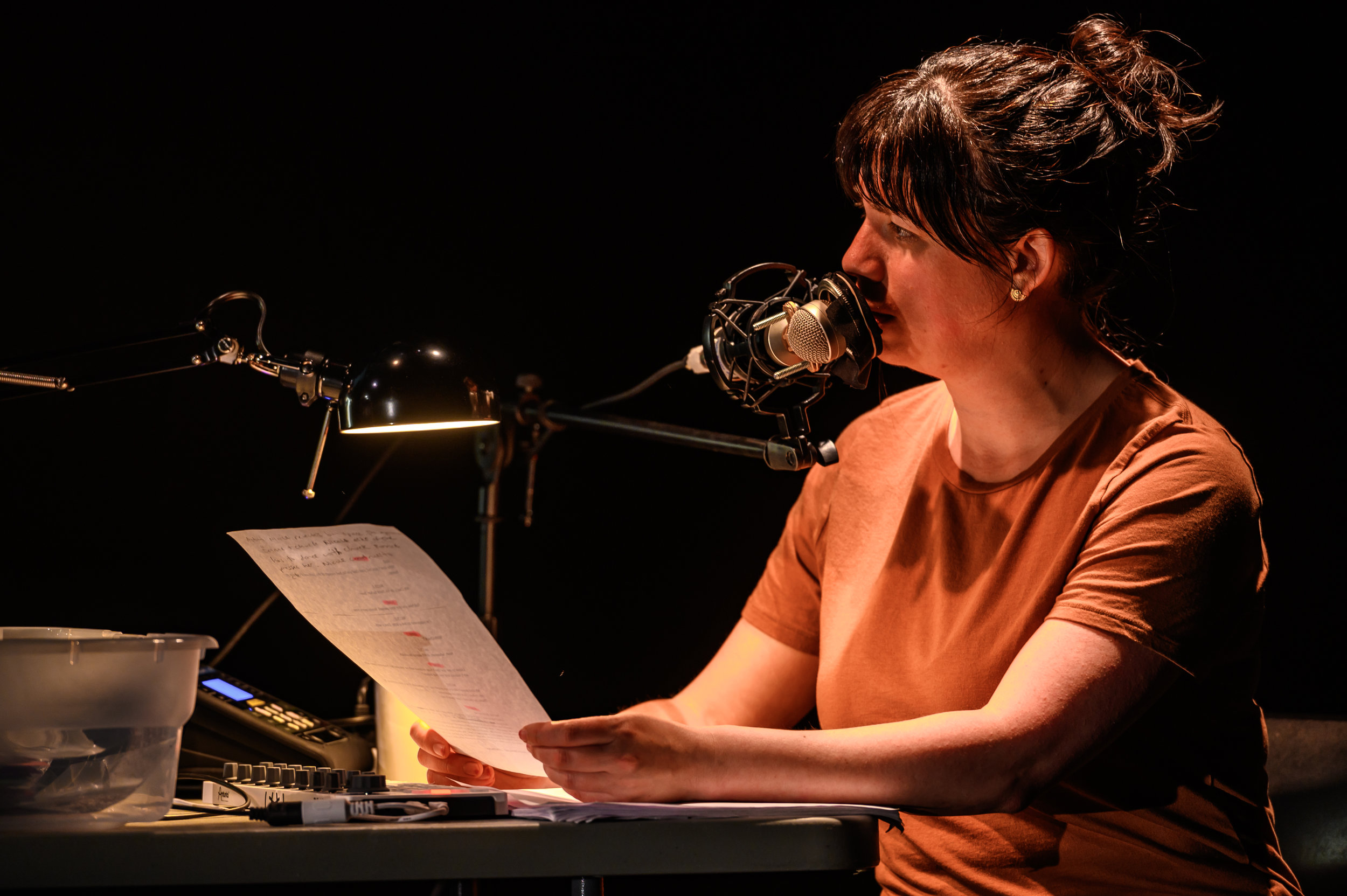
ARCHIVAL
pw: gba
Touring Overview
CAST: 4 Performers
CREW: 1 Stage Manager/Technical Director
RUNNING TIME: 65-70 minutes with no intermission.
PRESS
RISER Project review: 1991: Cole Lewis's autobiographical coming-of-age show is essential, powerful viewing, NNNN
Glenn Sumi
1991 is one of the more powerful, original shows to have come out of Why Not Theatre’s RISER project.
Set in the titular year, writer/director Lewis’s autobiographical coming of age story follows 12-year-old Nicole as she leaves her overworked, divorced mom in Southwestern Ontario to live with her dad in small-town Delaware for a while. A serial killer/rapist has been in the news in Ontario (likely the Paul Bernardo case), which is difficult enough to process as a young, curious girl on the edge of puberty. But that’s nothing compared to what Nicole encounters with her dad and his barroom buddies.
To reveal any more would be a spoiler. The most remarkable thing about the show is its presentation. Intentionally naive-looking cutouts are projected onto a screen and quickly moved around by Mina Jamesand Montserrat Videla to create the look and feel of a movie. What’s astonishing is how much variety there is in this format (projection designs are by Patrick Blenkarn and Lewis); perspectives shift, there’s lots of motion and the audience reads a lot into the blank-seeming characters.
Lewis voices Nicole (I’m assuming Cole is a shortened version of her name) while Jessica Carmichael, her voice often distorted by a microphone, speaks all the other characters in Nicole’s life. Carmichael’s rapid-fire character changes are stunning, and the mood of each scene is enhanced by Sam Ferguson’s sensitive sound design.
Best of all, the artists are open to exploring the full potential of their project. After a key scene, Lewis approaches the overhead projector and does something that is shocking... then builds on that action to evoke something even more shocking. (Warning: the play could be triggering for abuse survivors.)
The ending feels abrupt, but I hope this work has an extended life. Especially in light of the #MeToo movement and the discussion around consent, it’s essential, powerful viewing.
Istvan Reviews: 1991 | Guilty By Association / Why Not Theatre (RISER Project 2019)
Istvan Dugalin
This multi-media piece, set in the titular year, tells the coming-of-age story of Nicole, a 12-year-old drifter. After getting into some trouble with the police, and wanting to distance herself from the gruesome murder of a classmate by a local serial killer, she flees across the border to the Deep South, hoping to reconnect with her father—a boozy, fist-swinging Vietnam veteran.
Presented as a live-movie, 1991 has a decidedly analogue feel. With two overhead projectors centred on a long table, shadow puppeteers (Mina Jamesand Montserrat Videla) manipulate a variety of figures projected onto a large screen upstage. With black-and-white photographic elements establishing location, the scenes are broken up into a series of cleverly cinematic shots. The innovative visuals, created by Lewis and projection designer Patrick Blenkarn, have a jittery, low-tech charm that is enhanced, not hindered, by the inevitable glitches that occur.
Lewis provides the voice of Nicole. The other characters are performed by Jessica Carmichael, her voice digitally live-altered by sound designer Sam Ferguson. The format plays off our attention being torn between the visuals/audio and the performers creating them. Our suspension of disbelief ebbs and flows as our consciousness hovers between the story and the process through which it is told.
The synthetic quality of Carmichael’s distorted voice enhances this sense of blended technologies yet it was the one element that didn’t sit entirely well with me. Most aspects of the production feel distinctly gritty and human, so the electronic sound of the supporting characters seems somewhat incongruous. My ears adjusted well enough, but I think the warmth of a thoroughly human voice would have deepened the immersion.
With father and daughter on the road, the first part of the story bumps along rather light-heartedly. Their awkward, fumbling attempts at connection feel genuine and heart-warming. With the death of her classmate looming in the background and poverty hovering over them, they manage to find joy and adventure in their ragged, dumpster-diving way of life.
In a local dive bar, we are introduced to my favourite character: a female bartender whom Nicole clicks with immediately. Rough around-the-edges and sharp-tongued, her affection for Nicole is genuine and deeper than mere friendliness. She’s the only person who seems to intuitively understand the specific sort of guidance and reinforcement Nicole requires—and, more importantly, provides it.
An ominous dread creeps into the story as Nicole falls in with some ill-intentioned young men. As she is taken to increasingly more isolated locations, the hairs at the back of my neck prickle up, and the story’s lurking darkness rises to surface.
After a quietly traumatic incident, we follow Nicole in a thrilling rush of defiant, hopeful energy. Lewis concludes the show with a beautiful and haunting head-first dive into whimsical metaphor. The ending to Nicole’s story isn’t literal, it’s a hauntingly poetic ode to the resilience of youth and burgeoning self-actualization.
With a deceptively simple narrative thrust, 1991 offers bold and viscerally stunning moments that feel tangible and authentic—withsome that left me quite breathless.
RISER, 2019: Guilty by Association’s 1991
Mark Kreder
After having some time to digest 1991, I don’t think it would be right to say I enjoyed it. Instead, I will say I was affected by it, moved by it and am haunted by it. 1991, is Cole Lewis’ brutally honest coming of age story. There are many intense subjects that this show deals with that can be triggering for some. Lewis does not shy away from these, quite the opposite, she sheds light on them. There are support resources in the program, should members of the audience require them.
Part of what makes 1991 so intense is how it is staged. There are two tables set up on stage, with two projectors placed where the tables meet. Seated on the left is Lewis, who plays the main character, Nicole; on the right, is Jessica Carmichael, who with the aid of a vocal modifier, plays every other character in the play. In the middle, Mina James and Montserrat Videla, they control the projectors and projections throughout the show. It is almost as if the audience is inside the mind of Nicole and the projectors serve as our eyes into the world of 1991.
The design of the projections by Patrick Blenkarn and Lewis, are edgy and dark. Even when there are lighter moments in the script these are contrasted with the projections, which keep an ominous feeling of danger present. James and Videla work together fluidly while operating their specific projector and placing the projections down. My eye kept on being drawn from the projector screen to where James and Videla stood, moving along the story with a quiet focus. The entire ensemble shares this deep connection, it is because of this that it is difficult to look away, even at the most challenging moments of this piece.
There is very little comfort to be found in 1991. It begins with the aftermath of an assault, murder and dismemberment of a girl Nicole knew, Lucy. There is also only one character that provides a measure of help to Nicole and that is June, a bartender at a bar Nicole frequents often with her father. Nicole stands out as a light amidst this darkness that threatens her from all sides. Lewis plays Nicole with all the energy, vulnerability and innocence of a twelve-year-old girl, which plays perfectly against the plethora of characters that Carmichael voices. Carmichael plays each character with specificity, and humanity. She gives each character depth, which helps to intensify the action of the play.
There are many questions that 1991 ask its audience but it doesn’t provide answers and it is easy to walk away with a feeling of despair. In her director notes, Lewis talks about how 1991 is her attempt to understand the world she grew up in, specifically how that world is, “a world in need of change”. After reflecting on the ending of the show, I think it leaves the audience with hope. Change is possible, but one person can’t do it by themselves. The only way to create a better future, is together.
ARTIST PROFILES
Cole Lewis is the Artistic Director of Guilty by Association. Directing credits: AGMI for ArsNova’s Ant- Fest; Antigonick, Moderato Cantabile, and these violent delights for SummerWorks; Keith Richards: One Woman Show for Suitcase in Point. Playwriting credits: Kyo Maclear’s Virginia Wolf for Geordie Theatre; Untitled Nurse Project through seed commission from Stratford Festival. MFA in Directing, Yale School of Drama.
Jessica Carmichael is a non-status mixed Abénaki/Euro artist. Training: Acting, National Theatre School of Canada; MA Text & Performance, Royal Academy of Dramatic Art/King’s Col- lege London; MFA Directing, University of Alberta. Acting: with such companies as Native Earth Performing Arts, Thousand Islands Playhouse, Northern Light Theatre and Catalyst Theatre. Dramaturgy: recently Pawâkan Macbeth at the Stratford Festival.
Patrick Blenkarn is an interdisciplinary artist and director, often creating in the forms of performance, artist books, and video. Upcoming works include: culturecapital, a trading card game about the performing arts economy in Canada (Magnetic North); and asses.masses, a video game about donkeys dreaming of revolution (Risk/Reward).
Sam Ferguson is a Toronto-based sound designer and graduate of the Yale School of Drama. Recent credits include: these violent delights (GbA/SummerWorks) and Books (Simon Fraser University).
Claire Burns is a Toronto based queer actor, director, producer and theatre creator. Producing credits: The Philosopher’s Wife & The Scavenger’s Daughter (Paradigm Productions), Krapp’s Last Tape (Singing Swan/VideoCabaret/Theatre Passe Muraille),POSTSCRIPT- the Patio at the Fringe Festival (Toronto Fringe/Matthew Cohen Design Collective), Feminist Fuck It Festival (Storefront) Follow on insty: @clairzies.
COMPANY PROFILES
Guilty by Association (GbA) shifts our process with each new project as we conspire with an ever-expanding network of collaborators from far-out disciplines to faraway places. Led by Artistic Director, Cole Lewis, together we investigate what the “little world” of theatre can offer the larger world we live in. We also seek to expand what theatre can do, devising work from design ideas, exploring modes of storytelling, and scheming to fuse media to the stage.
Cole Lewis instigated GbA with fellow accomplices and founding members Lauren Dubowski, Nicholas Hussong, and Masha Tsimring at Yale School of Drama in 2012. By day, they masqueraded as MFA students in Directing, Dramaturgy, Projection Design, and Lighting Design. But late at night, as they created a show for the Yale Cabaret together, they plotted to uncover new possibilities for their art form.
The company is currently based in Vancouver, the unceded traditional territories of the Coast Salish peoples of the xʷməθkwəy̓əm (Musqueam), Skwxwú7mesh (Squamish), and Səl̓ílwətaɬ (Tsleil-Waututh) Nations.
Why Not Theatre is an agile, international theatre company based in Toronto, Canada, rooted in the values of innovation, community and collaboration. Our work is inventive, cross-cultural, and reflects our passion for the exploration of difference. We challenge the status quo, by examining what stories are being told, and who is telling them. More than just a theatre company, we develop creative strategies to build a healthier and stronger arts ecology. We MAKE and tour critically-acclaimed and award-winning new work, SHARE resources with other companies and artists to produce and tour their work, and PROVOKE change through new producing models and the presentation of work for new audiences. We are led by a core team of Founding Artistic Director Ravi Jain, Managing Director Owais Lightwala, and Executive Producer Kelly Read.
POST-SHOW ENGAGEMENT
OPTION 1: Q&As
OPTION 2: Long Table
PRODUCTION HISTORY
2019 In the Soil Festival, St. Catharines
2019 Why Not Theatre’s RISER Project, Toronto (PREMIERE)
2018 SFU Woodward’s, Vancouver
2018 Feminist Fuck It Festival, Storefront Theatre, Toronto
ACKNOWLEDGEMENTS
We respectfully acknowledge that this project was developed on the traditional and unceded territory of the Coast Salish peoples, specifically of the Səl̓ílwətaɬ (Tsleil-Waututh), Skwxwú7mesh (Squamish) and xʷməθkwəy̓əm (Musqueam).
The project has been made possible through the generous support of the Canada Council for the Arts, SFU Woodward’s Cultural Programs, and Why Not Theatre’s RISER Project.

